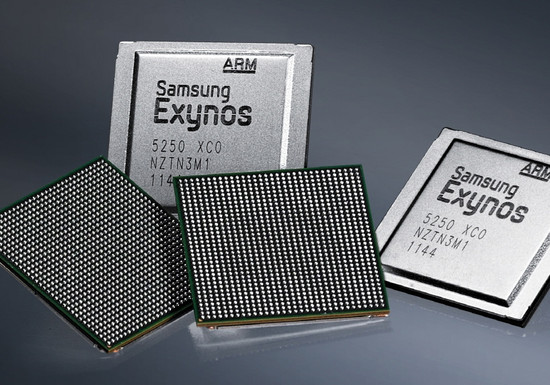Samsung Galaxy S II with its Exynos 4210 SoC is still one of the best Android phone. The company has demonstrated the system processor Exynos 4412 that is expected to appear in the successor.
Samsung’s new system processor builds on the company’s new 32 nanometer technology with HKMG (High-K, Metal Gate), and sports four Cortex-A9 cores. Exynos 4412 will beat the Exynos 4210 that builds on 45 nanometer, on all playing fields, both performance and efficiency. Samsung has not used a 4-Plus-1* approach like NVIDIA in Tegra 3.
Instead Samsung has optimized its chip with multiple functions for energy management, dynamic frequencies and voltages, and thermal control. Exynos 4412 will have its four cores clocked at 1.8 GHz and is expected to get the new graphics processor Mali-T604 from ARM, which will be up to five times faster than the already powerful Mali-400 that we find in Exynos 4210 and Galaxy S II. Samsung has a refresh coming for Exynos 4210, that has been shrunk to 32 nanometer and be called Exynos 4212. The two Cortex-A9 cores will be clocked at 1.5 GHz, and the graphics processor will be clocked higher for better performance.
We can expect Exynos 4412 to appear in the coming Galaxy S III, while Exynos 4212 will probably be used in cheaper smartphones and tablets. The Exynos 5 series, more precise Exynos 5250 with two Cortex-A15 cores will go into final testing and validation next month. This means this circuit will go into retail towards the end of the year, more likely in early 2013.
 Exynos 5250 will not appear in retail until late 2012 at best.
Exynos 5250 will not appear in retail until late 2012 at best.
The demonstration was held at a chip conference, but Samsung is expected to demonstrate Exynos 4412 at Mobile World Congress. NordicHardware will be there and hopefully indulge in more information on the new performance chip.
*4-Plus-1 is NVIDIA’s new name for its quad-core architecture with an energy efficient companion core in Tegra 3, which does all the background operations, for better efficiency and battery time.
Source: EETimes Asia via unwiredview















